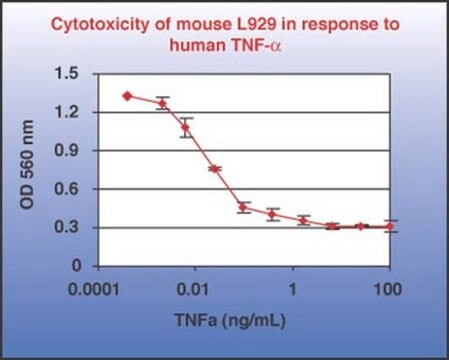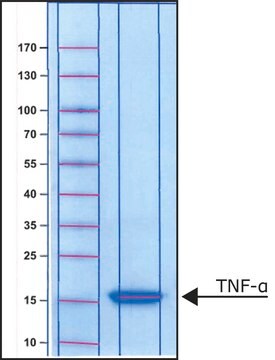11088939001
Roche
Tumor Necrosis Factor-α, human (hTNF-α)
recombinant (yeast)
Sinónimos:
hTNF, human necrosis factor
About This Item
Productos recomendados
biological source
human
Quality Level
recombinant
expressed in yeast
assay
≥95% (SDS-PAGE)
form
solution
potency
≤0.01 ng/mL EC50
specific activity
>1*10^8 U/mg (>1 x 10⊥8 U/mg, <0.01 ng/ml (hTNF-a, NIBSC, interim standard, 87/650), at least the same specific activity (EC50) compared to the indicated standard is guaranteed.)
mol wt
17,000 Da
packaging
pkg of 1,000,000 U (10 μg, 1ml)
manufacturer/tradename
Roche
storage condition
avoid repeated freeze/thaw cycles
impurities
<0.1 EU/μgtested (LAL test)
UniProt accession no.
storage temp.
−20°C
Gene Information
human ... TNF(7124)
Categorías relacionadas
General description
Recombinant, Tumor Necrosis Factor-α, human (hTNF-α), is produced in Pichia pastoris and purified by standard chromatographic techniques.
Primary structure: One polypeptide chain (157 amino acids), identical to natural hTNF-a.
Specificity
Application
- Shows cytolytic and/or cytostatic activity on a variety of transformed cell lines.
- Has activating and growth stimulating activities on a variety of normal cells.
- Has antiviral activity on many cell types in vitro.
- Can cause tumor necrosis of certain tumors in vivo.
Biochem/physiol Actions
Quality
Endotoxin level: <0.1 EU/μg (LAL-test), <10 EU/ml (LAL-test)
Sequence
Unit Definition
Physical form
Preparation Note
For complete cell lysis of sensitive cell lines about 1 ng/ml is recommended.
Working solution: Dilute the concentrated hTNF-α solution (10 μg/ml) with PBS or culture medium containing BSA (or HSA), 1 mg/ml (0.1%) or serum 1 to 10%.
Storage conditions (working solution): -15 to -25 °C
It is recommended to store the solution in aliquots at -15 to -25 °C.
Note: Avoid repeated freezing and thawing.
Other Notes
Storage Class
12 - Non Combustible Liquids
wgk_germany
nwg
flash_point_f
does not flash
flash_point_c
does not flash
Certificados de análisis (COA)
Busque Certificados de análisis (COA) introduciendo el número de lote del producto. Los números de lote se encuentran en la etiqueta del producto después de las palabras «Lot» o «Batch»
¿Ya tiene este producto?
Encuentre la documentación para los productos que ha comprado recientemente en la Biblioteca de documentos.
Nuestro equipo de científicos tiene experiencia en todas las áreas de investigación: Ciencias de la vida, Ciencia de los materiales, Síntesis química, Cromatografía, Analítica y muchas otras.
Póngase en contacto con el Servicio técnico




